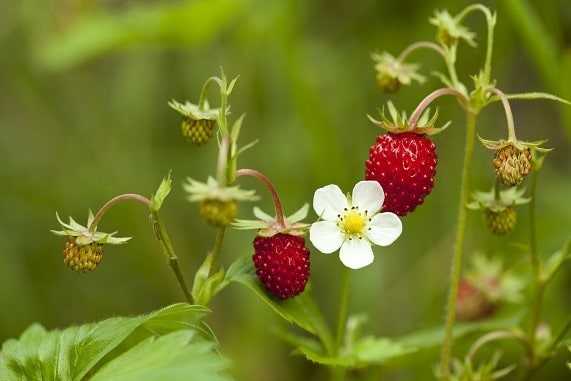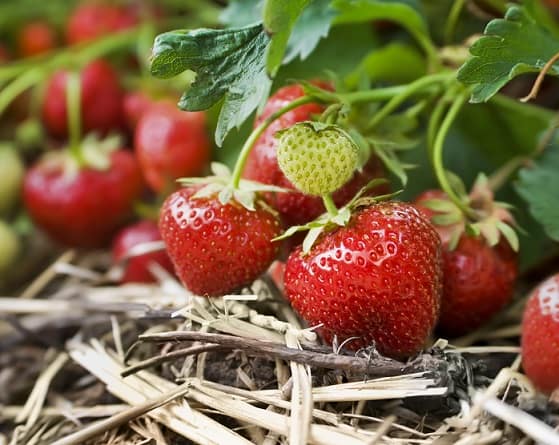 A couple of days ago we discussed garlic, how it’s an elite tier food for acne yet a burning, inflaming nightmare when applied to the skin. Today, we have a very different home remedy – strawberries.
A couple of days ago we discussed garlic, how it’s an elite tier food for acne yet a burning, inflaming nightmare when applied to the skin. Today, we have a very different home remedy – strawberries.
Strawberries are the complete opposite of garlic. Strawberries are also able to cure some of the root causes of acne when eaten, but this time, those benefits survive during topical application. In fact, the potential topical benefits of a strawberry mask almost mirror those of a strawberry meal.
Like with garlic, there’s still internet disinformation around: topical strawberries are easily less popular than lemon juice, but the rampant claims include 1) giving your skin a healthy pink tinge, 2) being soothing and calming, and 3) whitening both your skin and your teeth, 4) delaying ageing, and 5) ending oily skin. The problem with strawberries on the internet isn’t so much blatant falsehoods or ignorance of side effects, just lazy distortion and exaggeration of real facts over time.
Compared to lemon juice though (watch out!), there are no teenagers getting their skin ruined by faulty advice on strawberries. As for its powers, strawberries are a complex natural substance which scientists barely understand, with far more secrets compared to an isolated chemical like benzoyl peroxide.
The reality is that there’s no smoking gun for strawberries, but there’s almost no chance of side effects and a deluge of promising acne evidence.
Why strawberries have a positive nutrient profile
Firstly, let’s cover the basic powers, basic but still important. Like many fruits, strawberries are very rich in antioxidants, beaten by only pomegranates and other berries in a town marketplace.
Applying these antioxidants to your face will automatically deactivate the free radicals zooming around your skin causing chaos, keeping your skin cells bright and colourful and your pimples non-existent. The fact that most city and household air is so polluted in 2018 makes antioxidants vastly more useful compared to if we all lived in green, luscious valleys. No matter how hard you try, you’ll always be exposed to some free radicals nowadays, and strawberries can act as a shield.
Strawberries are also very rich in vitamin C, again beating almost all fruits. Vitamin C clears acne the best when eaten, as it decreases stress and makes your body’s collagen factories more efficient, but studies now show that topical vitamin C also increases collagen locally, because cells are able to pull in the ingredients they need.
Read Annihilate Your Acne – learn how to clear your skin permanently
As for strawberry’s side effects, there’s nothing to write about. Strawberries have no confirmed dangers to their name. They don’t have the sunlight sensitising psolarens of lemon juice. They’re missing the skin barrier disrupting oleic acid found in olive oil. Strawberries definitely don’t have the burning powers of garlic bulbs. The only risk is an allergy. Even if strawberries achieve nothing topically, there’s no downside to trying them.
With vitamin C and antioxidants, strawberries are automatically an acceptable ingredient in a natural skincare recipe. However, their powers are far more interesting than that…
Strawberry’s surprising power
 …because back in 2012, a potential new skincare strategy appeared from nowhere: scientists announced that strawberries could protect against UVB radiation in sunlight.
…because back in 2012, a potential new skincare strategy appeared from nowhere: scientists announced that strawberries could protect against UVB radiation in sunlight.
Italian and Spanish scientists created human skin cell cultures, and inundated them with a control and 3 different concentrations of strawberry extract, which were 0.05, 0.25 and 0.5 mg/ml. The cells were exposed to UV radiation beforehand.
The results were significantly decreased DNA damage to cells and increased cell survival and viability. The benefits correlated closely with the concentrations of strawberry, with the 0.5mg/ml extract being the most successful.
This study does raise many questions, but it’s still extremely promising. Firstly, was the increased protection simply due to the strawberry’s high concentration of normal antioxidants? If so, strawberries would be interchangeable with pomegranates, blueberries, raspberries and so on. Luckily, the answer looks like no, because three of strawberry’s specific antioxidants have UV protection studies to their own name.
Secondly, will the powers work on living human skin rather than an isolated skin cell culture? The answer is probably yes, or the scientists wouldn’t have bothered to test strawberries in the first place.
Positively, the sunlight tested was very strong, equivalent to 90 minutes of midday summer sun in the French Riviera.
Thanks to this study, UV protection is the strawberry’s most promising feature. Many sun-loving acne patients face a horrific choice. Spend a day on the beach and risk burning and inflammation, or apply sunscreen and watch while your existing pimples redden and develop a weird blurry tone.
Recommended – 6 vitamins and minerals which could finally clear your acne
For acne-clearing enthusiasts, it should be an ongoing quest to strengthen your skin so that it doesn’t burn anywhere as easily, and topical strawberries may be one way to achieve that. You can walk around the beach with a pink-tinged strawberry armour built into your face. We already have vitamin C and antioxidants, but UV protection is what makes strawberries really interesting.
The claim – strawberries are rich in salicylic acid
So what about the most frequently discussed claims? The biggest story about strawberries that they’re loaded with salicylic acid, a natural version of the common pharmaceutical cream. In acne, this chemical is used to melt away dead skin cells trapped in skin pores, being a type of chemical exfoliation, but with strawberries the claims have taken on a life of their own.
Strawberries do contain salicylic acid, but this isn’t a unique feature among fruits, and nor are they the greatest source.
100 grams of strawberries contains 1.36mg of salicylates according to one large study on 300 different foods. This easily beats most fruits, including pomegranates (0.07mg), apples (0.08mg to 0.57mg), mangos (0.11mg) and cherries (0.85mg), but is easily beaten by raspberries (3.14mg), apricots (2.58mg) blackberries (1.86mg), oranges (2.39mg) and blueberries (2.76mg). Furthermore, the levels in strawberries are dramatically lower than a dedicated salicylic acid cream from the shop.
It’s possible that strawberries contain a natural, more complex form of salicylic acid with superior properties, but that’s nothing but speculation. This story also created the common claim that topical strawberries can reduce oily skin, since salicylic acid breaks down the fatty acids in sebum. Once again though, the quantities in strawberries are far too weak.
Nevertheless, salicylic acid is another minor point in the strawberry’s favour – you just need to beware of the exaggeration.
This reflects a broader trend too. In your acne research, you should always remember that a lot of skincare articles throw in terms like tannins, antioxidants and polyphenols simply to whack people over the head with scientific credentials. Different websites and forum threads often circulate acne-clearing claims in a neverending game of Chinese whispers, so that by the time a substance is discussed, the author is using tenth hand information with no understanding of the original source.
7 natural topical treatments which can massively reduce acne
You should always be skeptical of such namedropping, and the salicylic acid of strawberries is a great example, even if it is promising. It’s just by pure chance that strawberries and salicylic acid have stuck together like glue. Identical cases are everywhere, like with apples and the gut-healing antioxidant quercetin, where dozens of other foods are actually a better source.
The claim 2# – strawberries can vaporise wrinkles
Getting back to strawberries, another character which constantly appears in articles is ellagic acid, touted to be an anti-ageing antioxidant which strawberries are loaded with. The truth? Ellagic acid itself undoubtedly lives up to the clouds of hype orbiting it.
This 2010 study is one of the most interesting I’ve seen in a while. Scientists began by blasting some skin cells with intense solar radiation. They observed the usual damage, but ellagic acid was able to reverse all of it. When UV radiation decreased the viability and survival of keratinocyte cells (the building blocks of skin), ellagic acid restored it. When UV radiation decreased type 1 collagen levels in skin cells, ellagic acid increased it. When human enzymes responsible for breaking down collagen called matrix metalloproteinases increased, ellagic acid decreased them.
Since collagen is in the top 3 substances linked to youth and ageing (hyaluronic acid is another), the scientists concluded promisingly that using ellagic acid “may be promising treatment strategies interrupting skin wrinkle and inflammation associated with chronic UV exposure leading to photoageing“.
Could ellagic acid be the compound behind strawberry’s sunscreen properties? More importantly, is it a hidden way to gain the youthful skin of a vampire, buried beneath mountains of scientific studies? It’s almost certainly not the only reason, with strawberries containing dozens of notable polyphenols and anthocyanins.
The important question yet again is whether strawberries contain high enough quantities. Strawberries feature 1.1mg of ellagic acid per 100 grams of weight, defeated by pomegranate, blackberries and blueberries, but still richer than the vast majority of fruits. Strawberries contain far less ellagic acid than the study above, but it could still be enough to have subtle benefits.
Read this article and learn why vitamin A is great for oily skin
There’s a couple of technical questions too, namely 1) whether ellagic acid is absorbed into living, breathing human skin, given that the study above used a test tube, and 2) whether any of strawberries’ other antioxidants could counteract ellagic acid in a real life scenario.
Like with salicylic acid, the anti-ageing claims are exaggerated, but this time they’re far more promising, particularly given the strawberry’s richness in vitamin C and antioxidants, both of which are beneficial for youthfulness themselves. The powers of strawberries are slowly but surely adding up.
Other possible skin enhancers
 Digging deeper into some speculative benefits, we have the countless antioxidants that scientists have identified in strawberries so far. Cinnamon has cinnamaldehyde, grapes contain resveratrol and ginger contains gingerols. Strawberries lack any real standout compounds, but nevertheless, they contain…
Digging deeper into some speculative benefits, we have the countless antioxidants that scientists have identified in strawberries so far. Cinnamon has cinnamaldehyde, grapes contain resveratrol and ginger contains gingerols. Strawberries lack any real standout compounds, but nevertheless, they contain…
Pelargonidin-3-O-glucoside – an anthocyanin which strawberries are the best known source of, with 20 times the quantity of raspberries. So far, a single study on inflammation was fairly weak, but this is close to strawberry’s signature antioxidant and more benefits could reveal themselves.
Epicatechin – a much more widely distributed antioxidant. Cocoa beans are the best source, but strawberries rank highly. Epicatechin has wild claims circulating that it can enhance muscle mass, but this polyphenol also has yet another UV radiation study to its name. Epicatechin also has a treasure trove of strong antioxidant studies.
Cyanidin 3-glucoside – also called chrysanthemin. Found in strawberries in unexceptional yet strong quantities. Chrysanthemin is the reason why the experimental purple corn has its purple colour. Has two studies showing UV radiation protection in the skin, one on mice and one on humans. Benefits included preventing depletion of glutathione, strengthening UV exposed cells, and preventing increases in pro-inflammatory immune system chemicals.
p-Coumaroyl glucose – found in other berries but mostly in strawberries. This antioxidant is completely unresearched.
4-Hydroxybenzoic acid 4-O-glucoside – same theme. Little research for this rare antioxidant and only blackberries come close to strawberries.
All this nutritional goodness gives strawberries more and more potential, especially compared to cucumbers or melons which lack the variety of antioxidants that strawberries have. And again, strawberries are free from side effects, giving you huge room to experiment. Garlic actually contains far more unique compounds than strawberries, but that road is permanently out of bounds given the snag of second degree chemical burns.
Should acne patients eat strawberries or apply them?
Obviously if you’re a lazy Roman emperor with slaves throwing strawberries into your mouth, doing both is ideal, but in the real world, it depends on how much progress you’ve made in your acne strategy.
If you’re only just understanding how much diet can affect your acne then you need to shovel some high antioxidant foods into your body right now, and strawberries fit the bill. If you’ve already arranged a diet which you think is perfect, have cleared acne, and want to take your skin to the next level, strawberries are a great topical treatment to experiment with.
As a rule, diet easily takes precedence over topical treatments, because with the latter, you’re not truly treating the problem. You’re just playing whack a mole with an endless conveyor belt of new pimples which pop up, while doing nothing to address why they’re appearing, even if dermatologists have persuaded you that hygiene is the main cause of acne (which it isn’t).
Always fix your diet, lifestyle and other factors that affect your health first. Your acne and skin’s vitality and glow are just a reflection of your internal health. Case in point: if your body is deprived of antioxidants and phytonutrients, your skin will be deprived of glow and colour, with the grey and pallid tone of the undead.
Topical treatments are the next stage of your acne strategy once you’ve dealt with the fundamentals. They’re the area where you move beyond eliminating a problem, which is acne, to acquiring something amazing, which is glowing and alive looking skin.
Focusing on topical treatments is like advancing to the next level of a videogame. Topical treatments are also where you compensate for bodily factors that are hard to control, like an overdose of chemicals in your tap water, an inability to afford organic food, strange hormonal conditions, or to some extent, stress.
The one advantage with applying strawberries topically is that their roster of substances is applied to your skin directly. There’s no dilution as they disperse to your entire body. This is particularly useful with vitamin C and antioxidants. Epicatechin actually penetrates the brain blood barrier, and you don’t want your antioxidants wasting time there, you need them for your skin (half joking).
The verdict
Topical strawberries are a decent home remedy. They lack an individual standout property, but what strawberries do have is five different potential minor powers.
Strawberries are a particularly well rounded topical treatment, compared to the antibacterial apocalypse of tea tree oil. The improvements probably won’t be noticeable with a casual glance in the mirror every morning, but they probably will be noticeable when examining a daily camera image over 2 weeks. There’s no way that you’ll remove entire wrinkles, but strawberries could be one part of an anti-ageing jigsaw puzzle.
I strongly recommend combining strawberries with topical treatments with similar powers. Examples include tamanu oil for collagen, or grapeseed oil with its vitamin E, an antioxidant which strawberries lack, thus forming an unbeatable antioxidant alliance.
Fresh strawberries are not the only option either. On amazon, there are numerous bags of strawberry powder for sale. They’re designed for usage in recipes, but in reality they’re perfect for skincare. All the liquid, fiber and seeds are extracted, leaving only a condensed essence of the strawberry where every nutrient will be in huge quantities.
The final judgement is this: the salicylic acid content of strawberries is definitely exaggerated, and they won’t clear your acne singlehandedly, but topical strawberries have potential as a home acne remedy.
NEXT: forget creams and moisturisers – discover the ultimate acne-clearing diet
Thanks for reading!